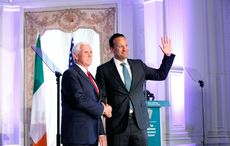| Senator Scott Brown in discussion with Eamon Gilmore |
Two Irish E-3 bills were introduced in the Senate late last year, one by Senator Charles Schumer of New York and one by Senator Scott Brown of Massachusetts. An amalgamated version of the bills is awaiting final action in the Senate, and Irish sources are cautiously optimistic of success.
The term E-3 has been bandied about a lot these days, but what exactly is an Australian E-3 visa, and how does it work?
It’s a question that this column has been asked on more than one occasion, so here we’ll give the basics about the initiative that was tailor made for the Australians back in 2005. Keep in mind that any E-3 program for the Irish could be somewhat different to what’s described here.
The Australian E-3 has been in existence since 2005, when Congress authorized – and President George W. Bush approved – 10,500 annual non-immigrant work visas specifically for natives of Australia.
Those eligible to apply for an E-3 visa must first have a job offer from an American employer, and the position must be considered a “specialty occupation,” – i.e., one in which a bachelor’s degree would be required as a minimum.
------------------
Read more:
More news on Irish immigration from IrishCentral
Kevin Costner delivered an emotional eulogy at Whitney Houston's funeral - VIDEOS
Niagara Falls to go green for St. Patrick’s Day in tourism push for Ireland
------------------
The possibility also exists for those without college degrees to apply for an E-3 visa. However, they would have to have a wide body of experience – three years of work experience is generally accepted as the equivalent of a single year of college, so 12 years of work experience could, if the circumstances are right, equate to a four year bachelor degree.
The E-3 visa has particular advantages over the H-1B visa, which is used by citizens from other parts of the world who have U.S. job offers in specialty occupations.
The application process for the E-3 is less cumbersome and quicker than the H-1B because the employer is not required to file a visa petition, and only has to obtain an approved Labor Condition
Application (LCA) from the Department of Labor.
Spouses of E-3 visa holders also have the right to employment in the U.S., a benefit not given to H-1B spouses. The E-3 spouse must apply for an employment authorization document with the U.S. Citizenship and Immigration Service (USCIS) after arrival here.
The approved document allows the spouse not only the right to work in the U.S., but the job may be in a position other than a specialty occupation. The job can also be either full-time or part-time.
The spouse of an E-3 visa holder does not have to be a native of Australia to fully partake of the program’s benefits. Children are also eligible to come to the U.S. on the E-3 visa program, but they cannot obtain work authorization.
Best of all, the E-3 visa, initially granted for two years, is renewable for an indefinite amount of time. H-1B visas are issued for one three year period, with only one three year renewal possible.
The E-3 visa is employer-specific – in other words, the holder can only work for whoever acted as visa sponsor. If another job offer comes up, the new employer must obtain another LCA, and a new E-3 application would have to be filed.
E-3 visa holders are free to travel abroad as they wish for business, vacations, etc., as long as they are still employed and are maintaining a primary base in the U.S.
Though there are 10,500 E-3 visas available to qualified Australians each year, thousands go unfilled.
The Australian economy is stronger than the Irish one so the need for emigration isn’t as great. For fiscal year 2010, only 2,175 E-3s were issued; the number was 2,191 the previous year, and 2,961 in 2008.
So basically, more than 7,500 E-3s are untaken each year. If an E-3 Irish visa comes to pass, it’s a sure bet that the quota will be used.




Comments